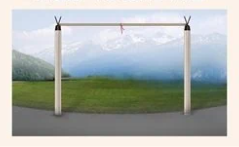My chavruta and I have been learning the Gemara in Eiruvin this year and I recently stumbled on a sugia that seems very relevant to a previous post.
As you may recall, in 2018 we went camping over Shabbat Chol Hamoed Sukkot. This necessitated the challenge of building both a small Sukka and an Eiruv so that we could carry items around our camp site on Shabbat.
The Eruv construction method I went with was simple- four 3 meter tall bamboo poles stuck in the ground around our campsite(4 or 5 tents around a mat for eating on), with heavy metal screw inserted at the top. A metal wire was then stretched taught between the four screws at the top of each pole, thus creating a "צורות הפתח" on each side. This was a simple solution that required few materials. That said, the 3 meter poles can be a bit tricky to secure. There are also a number of laws of "צורות הפתח" that need to be minded to have a kosher Eiruv.
Now lets' look at Eiruvin chapter 1, Mishnas 8-10:
שַׁיָּרָא שֶׁחָנְתָה בְּבִקְעָה וְהִקִּיפוּהָ בִכְלֵי בְהֵמָה, מְטַלְטְלִין בְּתוֹכָהּ, וּבִלְבַד שֶׁיְּהֵא גָדֵר גָּבוֹהַּ עֲשָׂרָה טְפָחִים, וְלֹא יִהְיוּ פְרָצוֹת יְתֵרוֹת עַל הַבִּנְיָן. כָּל פִּרְצָה שֶׁהִיא כְעֶשֶׂר אַמּוֹת, מֻתֶּרֶת, מִפְּנֵי שֶׁהִיא כְפֶתַח. יָתֵר מִכָּאן, אָסוּר:
מַקִּיפִין שְׁלֹשָׁה חֲבָלִים, זֶה לְמַעְלָה מִזֶּה וְזֶה לְמַעְלָה מִזֶּה, וּבִלְבַד שֶׁלֹּא יְהֵא בֵּין חֶבֶל לַחֲבֵרוֹ שְׁלֹשָׁה טְפָחִים. שִׁעוּר חֲבָלִים וְעָבְיָן, יָתֵר עַל טֶפַח, כְּדֵי שֶׁיְּהֵא הַכֹּל עֲשָׂרָה טְפָחִים:
מַקִּיפִין בְּקָנִים, וּבִלְבַד שֶׁלֹּא יְהֵא בֵין קָנֶה לַחֲבֵרוֹ שְׁלֹשָׁה טְפָחִים. בְּשַׁיָּרָא דִבְּרוּ, דִּבְרֵי רַבִּי יְהוּדָה. וַחֲכָמִים אוֹמְרִים, לֹא דִבְּרוּ בְשַׁיָּרָא אֶלָּא בַהֹוֶה. כָּל מְחִצָּה שֶׁאֵינָהּ שֶׁל שְׁתִי וְשֶׁל עֵרֶב, אֵינָהּ מְחִצָּה, דִּבְרֵי רַבִּי יוֹסֵי בַּר רַבִּי יְהוּדָה. וַחֲכָמִים אוֹמְרִים, אֶחָד מִשְּׁנֵי דְבָרִים. אַרְבָּעָה דְבָרִים פָּטְרוּ בַמַּחֲנֶה, מְבִיאִין עֵצִים מִכָּל מָקוֹם, וּפְטוּרִים מֵרְחִיצַת יָדַיִם, וּמִדְּמַאי, וּמִלְּעָרֵב:
The Misha teaches that the requirements for an Eiruv for a temporary encampment are actually less stringent than for a permanent settlement. The requirements listed in the Mishna include:
- The Eiruv can be a temporary "fence" 10 handbreadths high constructed from saddles, bags, and other equipment piled up for this purpose
- The fence can have breaches, as long as the fenced length is greater than the breached length(up to a maximum breached width)
- If you build a fence with posts, you only need 3 cords, each within 3 handbreadths of one another
- You can also use vertical reeds spaced a distance of 3 handbreadths
- No Eiruv chatzerot is required for the area shared between tents
I need to research the practical halacha more, but from this it sounds like alternative Eiruv constructions techniques could potentially include:
1. Arranging your tents in a tight circle, then filling some of the breaches between them with luggage up to 10 handbreadths high
2. A stake & chicken wire fence(10 handbreadths high)



No comments:
Post a Comment